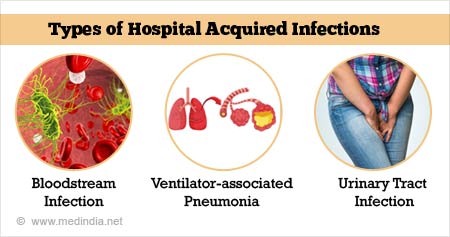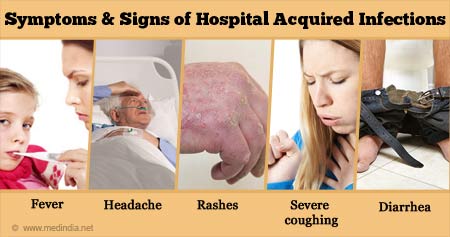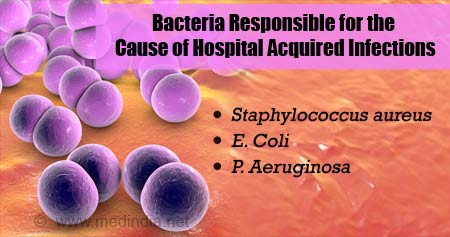Which Term Describes a Hospital Acquired Infection
Hospital acquired infections HAIs is a major safety concern for both health care providers and the patients. The infections that spread through fomites in the hospital environment are called hospital-acquired infections or healthcare-associated.

Hospital Acquired Infections Nosocomial Infections Types Causes Symptoms Risk Factors Diagnosis Treatment And Prevention
Mode of transmission B.

. These infections are usually acquired after hospitalization and manifest 48 hours after admission to the hospital. A high cost or high volume or both b result in the assignment of a case to a DRG that has a higher payment when present as a secondary diagnosis and c could reasonably have been prevented through the. ___ The most frequently lethal site of hospital acquired infection ___ Very frequent type of hospital acquired infection usually involving gram positive pathogens.
Even a doctors office or clinic can be a source for an HAI. Patient Safety and Adverse Events Composite CMS PSI 90 We calculate the CMS PSI 90 using Medicare Fee-for-service claims. In the community it is usually auto-infection.
PSI 06 Iatrogenic Pneumothorax Rate. PSI 03 Pressure Ulcer Rate. 1 the term hcais initially referred to those infections linked with admission to an acute-care hospital earlier called nosocomial infections but the term now includes infections developed in various settings where patients obtain.
A nosocomial infection is contracted because of an infection or toxin that exists in a certain location such as a hospital. Ventilator-associated pneumonia VAP is a term used to describe pneumonia lung infection that develops in a patient who has been on mechanical ventilation for more than 48 hours. Hospital patients is diagnosed with at least one infection related to hospital care alone.
Infections acquired in a hospital are also called nosocomial infections. Considering morbidity mortality increased length of stay and the cost efforts should be made to make the hospitals as safe. A hospital-acquired infection is an infection caught while hospitalized.
Both in hospitals and long-term care facilities causing more than 16 million additional hospital days 90000 deaths and an. In hospitals it is usually hand-borne infection. This report describes national and state progress in preventing central line-associated bloodstream infections CLABSI catheter-associated urinary tract infections CAUTI select surgical site infections SSI hospital-onset C.
According to the Centers for Disease Control and Prevention what is the most common hospital-acquired infection. Health care-associated infections hcais are those infections that patients acquire while receiving health care. Difficile infections and hospital-onset methicillin-resistant Staphylococcus aureus MRSA bacteremia.
PSI 09 Perioperative Hemorrhage or Hematoma Rate. What is the definition of a hospital-acquired infection HAI An infection that is acquired in the hospital after 48 hrs of admission - also called nosocomial or iatrogenic infections. When a patient is ill or injured they may have a compromised immune system that is not successful in fighting off these infections when they are exposed to them.
To emphasize both hospital and nonhospital settings it is sometimes instead called a healthcareassociated infection. The panels describe the rapid contact-killing efficiency of various copper. An infection that is acquired or develops during a persons stay in a hospital or other health facility is called an _____ or nosocomial infection.
Which area would you live in if you would like to avoid getting coccidioidomycosis. Nosocomial infections also referred to as healthcare-associated infections HAI are infection s acquired during the process of receiving health care that was not present during the time of admission. Match each term with the phrase that best describes it.
Healthcare-associated infections HAIs are complications of healthcare and linked with high morbidity and mortality. Each year about 1 in 25 US. Such an infection can be acquired in hospital nursing.
The Centers for Disease Control and Prevention CDC estimate that more than two million patients develop hospital-acquired infections in the United States each year. The prefix noso- comes from nosus meaning disease and -comial comes from komeion meaning to take care of. A hospital-acquired infection also known as a nosocomial infection from the Greek nosokomeion meaning hospital is an infection that is acquired in a hospital or other health care facility.
___ Frequent acquisition pathway for hospital acquired pneumonia. ___ When hospital acquired can cause pneumonia. A nosocomial infection is strictly and specifically an infection not present or incubating prior to admittance to the hospital but generally occurring 48 hours after admittance The word nosocomial is made up of two Greek words.
Nosocomial infection means hospital-acquired infection. A term that pertains to genetic differences that can cause a drug to affect us in different ways whether therapeutically or adversely is known as. Which of the following is NOT a term used to describe a hospital-associated infection.
The CMS PSI 90 measure includes. A chronic condition is a human health condition or disease that is persistent or otherwise long-lasting in its effects or a disease that comes with time. Which term describes the presence of the bacteria on a persons body without observable symptoms.
Description About 5-10 of patients admitted to hospitals in the United States develop a nosocomial infection. Healthcare-associated Select the four most prevalent types of healthcare-associated infections. Community-acquired infections develop outside a healthcare facility.
Surgical site infection C. PSI 08 In Hospital Fall with Hip Fracture Rate. See Transmission of Disease Correct.
The medical community calls HAIs nosocomial infections. A patient may develop an infection in hospitals that are not as clean as they. Hospital-acquired infections HAIs are often caused by bacteria and other pathogens that are prevalent in a healthcare environment.
Ventilator-associated pneumonia is the second most common hospital-acquired infection among pediatrics and neonatal intensive care unit patients. Section 5001 c of Deficit Reduction Act of 2005 requires the Secretary to identify conditions that are. A healthcare-acquired infection HAI is an infection contracted in a healthcare facility such as an acute care hospital or a skilled nursing care facility.
Hospital-acquired infections also known as healthcare-associated infections HAI are nosocomially acquired infections that are typically not present or might be incubating at the time of admission.

Hospital Acquired Infections Nosocomial Infections Types Causes Symptoms Risk Factors Diagnosis Treatment And Prevention

Nosocomial Infection What Is It Causes Prevention And More Osmosis

Hospital Acquired Infections Nosocomial Infections Types Causes Symptoms Risk Factors Diagnosis Treatment And Prevention
Comments
Post a Comment